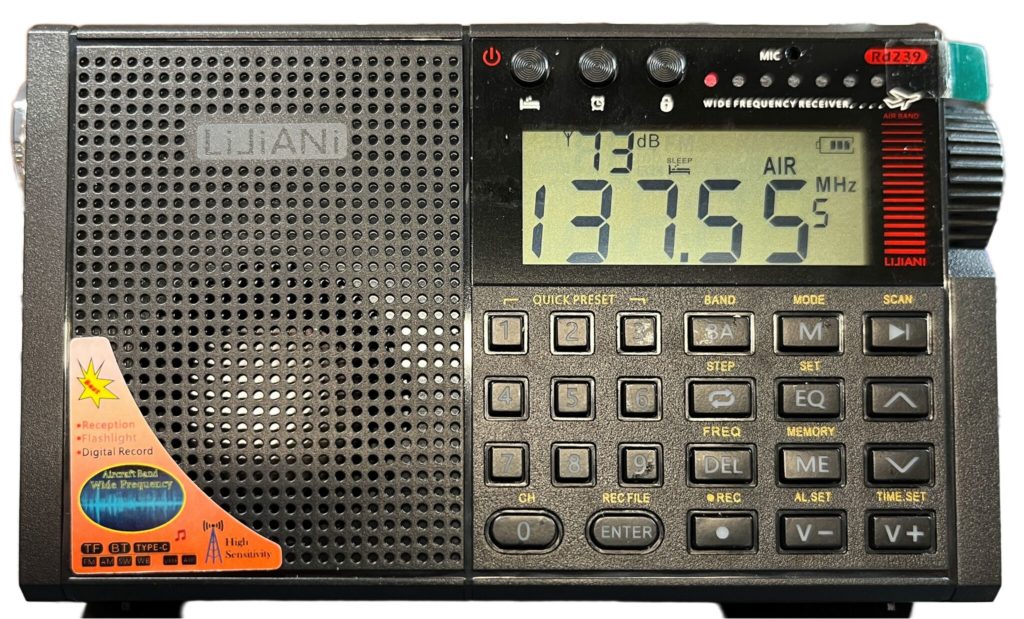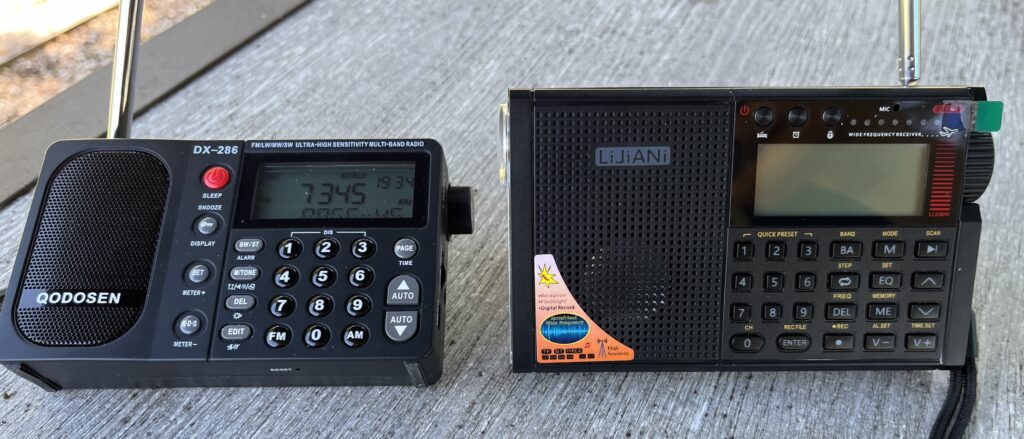I bought the LiJiANi Rd239 in November of 2023 because of long list of features and a blow-out Black Friday price on Amazon. My article, LiJiANi Rd239: A different radio, reviewed the radio. Since then it’s been the radio I keep in my car, and in that role it’s not used much and tends to get overlooked when comparing things. Other articles about it include:
- Updating the LiJiANi Rd239 radio firmware
- XHDATA D-109WB vs LiJiANi Rd239 Multiband Receivers
- Thunderous Clash of the Weather Radios
- FM Radio Shootout

The new kid on the block, the Qodosen DX-286, has caused a lot of excitement in the SWL community because of its outstanding FM performance and a mountain of options. I bought the early version, the SR-286 in February of 2024, and wrote several articles, including, The Burning Question: is the Qodosen SR-286 worth it? At that time the price was somewhat high, but has come down for the mass market DX-286 model (essentially the same radio but with some firmware changes). Other articles:
- Qodosen DX-286 vs Sihuadon R-108
- The New Qodosen DX-286
- Incoming Radio! Qodosen DX-286
- Tecsun PL-330 or Qodosen SR-286?
- Qodosen SR-286 Tuning Tutorial
- Qodosen SR-286 Update
- Qodosen SR-286: First Impressions
- Incoming Radio! Qodosen SR-286
- FM Radio Shootout

Both radios are quite small and reasonably priced. Both are interesting, but for different reasons.

And for those who want the quick and dirty: The Rd239 wins on features and price, while the DX-286 wins on quality and ease of operation. I think the Rd239 is better on FM. The DX-286 is better on MW and they’re pretty close on shortwave.
Features
Feature table anyone?
| Feature | DX-286 | Rd239 |
|---|---|---|
| LW (kHz) | 144 – 519 | |
| MW (kHz) | 520 – 1710 | 520 – 1710 |
| SW (kHz) | 1711 – 27000 | 3200 – 29999 |
| FM (MHz) | 64 – 108 | 76 – 108 |
| FM RDS | Y | |
| AIR (MHz) | 118 – 138 | |
| VHF (MHz) | 30 – 200 | |
| Weather (MHz) | 162.4 – 162.55 | |
| Weather Alerts | Y | |
| ATS Memories | 1000 | 540 (108 per band ex Weather) |
| Squelch | Y | Y |
| External Antenna | All bands | FM/SW/VHF/WB/AIR |
| Mute button | Y | Y |
| Flashlight | Y | |
| Reading light | Y | |
| Backlit keys | Y | |
| Bluetooth Play | Y | |
| TF Card Play | Y | |
| TF Play Equalizer | Y | |
| Record from Radio | Y | |
| Record from Microphone | Y | |
| AUX input | Y | |
| Alarm | Radio/Buzzer | Radio/Buzzer |
| Clock | Dual Time | Not visible with radio off |
| Sleep timer | Y | Y |
| Display illumination | Smart/Always on | Smart with 5, 10, 15, 20 seconds option |
| Speaker | 3W | 3W |
| Antenna Len (cm) | 51 | 61 |
| Wrist Strap | Fixed | Removeable |
| Size (mm) | 30 x 76 x 134 | 28 x 85 x 138 |
| Battery | 18650 | BL-5C or 3 AA |
| Charge | USB Micro | USB-C |
| Firmware version | 3.0 | |
| Available colors | Black | Black, Green |
| Amazon price (6/24/2024) | $79.99 | $55.90 less a $6 coupon |
The Rd239 is a Swiss army knife when it comes to features, not only on bands covered but auxiliary features like a very bright flashlight, Bluetooth/MP3 and recording. The DX-286 has FM RDS, and both lack decoding for SSB.
The DX-286 does add a very powerful LW reception feature, and it allows using the external antenna for MW/LW.
Fit and Finish
One immediately notices the more polished appearance of the Qodosen. The radio feels more substantial, the case is better looking, the speaker grill is metal, the knob feels better, the buttons are more reliable.
The DX-286 has far and away the easiest to read labeling. The Rd239 with its gray writing on black buttons is unusable in dim lighting, except when they are illuminated. Also the Rd239 buttons are somewhat crowded. It’s a little confusing that the secondary button labels are above the buttons on the Rd239 and below the buttons on the DX-286.
My number one quality issue with the LiJiANi Rd239 is its thin antenna. I hesitate to use the word “flimsy” but that’s how I think of it. I just yank out the Qodosen DX-286 antenna, but I feel that I have to be extra careful with the 10 mm longer Rd239 antenna, and it also operates less smoothly. The Rd239 has molded plastic feet, unlike the more secure rubber feet on the DX-286.
Operation
I like radios with simple manual frequency entry. Tuning a frequency mentioned on Facebook is easy on the DX-286. No matter what the state of the radio previously, just turn it on, press the frequency buttons and press AM or FM as appropriate. On the Rd239, one has to press the power button, wait a second, press the power button again. Then one has to figure out what band is currently selected, and if not the desired one, the band button has to be pressed from 1 to 5 times to select the desired band. Then one has to press the FREQ button to let the radio know that a frequency is coming, press the buttons for the frequency and finally press ENTER.
I talked about ATS and memory systems at length, including these, in my article: Radio Memory Systems and I refer the reader there, but today I did a SW band scan on the Rd239 and was reminded of how painfully slow it was, almost 9 minutes (noting that it covers the entire range and not just broadcast frequencies), compared to a little over a minute and a half on the DX-286.
Both radios have a mute button that’s super convenient when making comparisons.
Reception
Let me preface this section with the basic problem I have with all my radio reviews: I live in a weak signal area, so I never see problems with overloading from strong local broadcast stations. For example, the XHDATA D-109 works very well here, but others in cities with strong signals find it poor.
Qodosen has been busy getting review radios out to influencers (even a 4th-tier writer like me) and this has resulted in quite a bit of online coverage, including an ongoing series of videos at the OfficialSWLChannel on YouTube. Gilles Letourneau lives in Montreal among strong broadcast stations and he’s found no overload problem.
Since everybody raves about FM reception on the DX-286, I was surprised to find that the Rd239 was actually more sensitive on FM. Here’s a short video comparing the DX-286, Rd239 and Tecsun PL-330. The Rd239 was the clear winner here and in other tests. It appears that at some low signal levels, the DX-286 just can’t hold onto the signal.
MW
I’ve found the DX-286 phenomenal on MW, especially with an external antenna which it supports. The Rd239 is only average. Here is my comparison chart:
What was surprising is that the DX-286 receives far more MW stations (about 20 more) using its telescopic antenna with the antenna switch set to external. With a real external antenna it just keeps getting better.
SW
That leaves shortwave, the test that has always caused me the most trouble because of local noise. I took the two radios out this afternoon for a short (pun intended) spin. There really wasn’t much difference, beyond the general fact that the Rd239 can be turned up louder. Here’s about 5 minutes worth of weak signals, hand held, with the telescopic antenna, heard here in central Virginia around 19:50 UTC.
When I set up this video, I ran a band scan on the DX-286 because it is fast and catches weak stations. That’s how I selected these stations.
Audio
Both of these radios can be turned up loud, unlike some other portable shortwave radios I could mention, but the Rd239 is louder.
I found the DX-286 to have good clarity with better high frequency response, and the Rd239 to have better bass, much better bass with the right source material. Here I was tuned to Radio Exterior de España on 15,520 kHz in the afternoon playing some lovely guitar music outdoors. The bass was so powerful that the radio literally walked on the table (faster towards the end).
Conclusion
Sorry, but you have to buy both of them.

I watched a lot of your videos today. Many people think that the FM of 286 is top-notch, but the AM of 286 is a little worse, not reaching a very high level. I tested RD908 (new version) today. The AM of RD908 is obviously higher than 286.. but the FM is not as good as 286. I hope you can professionally test the AM of RD908.
Take the DX286 out of auto band with in FM..The auto tries to get it too narrow the weaker the signal.widen it up and it will sound great and cleaner than the competition
That makes sense, particularly in North America where channels are 200 kHz apart.
SSB Wanted!
Hi,
Strange that the Tecsun 880/990 give more stations than the Qdosen dx286.
There is no narrow/wide for FM on these Tecsuns?
Marc
The Tecsuns have a tone switch. They also have a longer antenna.